9 August, 2002
Science could not happen on board the USCGC Healy without a dedicated group
of coast guard crew called the MST's. They are the Marine Science
Technicians who facilitate all the science operations on board. They have a
long list of duties related to our work among which are:
- deploy and recover every piece of scientific oceanographic equipment
that goes into the water,
- assist the scientists in the laboratories,
- handle and store hazardous materials for the scientists and the
crew,
- provide weekly briefings for the ship and for the aviation
detachments (the helicopter pilots),
- perform ice imagery analysis on board the ship,
- report weather observations to NOAA (National Oceanic and
Atmospheric Administration),
- provide a report of marine mammal sightings to NOAA,
- operate the ship's installed scientific equipment such as the CTDs
and the ACDP (Acoustic Current Doppler Profiler).
LTJG Mike Woodrum is the Marine Science Officer in charge of the MST's. He
is the official liaison between the Coast Guard and the science party on
board. His principal job is to coordinate all the science missions on board
the ship. Although the spring SBI cruise left in late May of this year,
Mike was in contact with the some of the scientists as early as November of
2001. Mike's primary job is working with the MSTs but he spends a good deal
of his time on the bridge driving (conning) the ship.
Senior Chief Marine Science Technician Glenn Hendrickson coordinates the
operation of the marine science division. As he says, he is like the
principal in a school who guides the teachers who actually get the job done.
If that is the case, he is a very active "principal" as we often see him out
on deck or in the aft con (rear conning area) when equipment is in use.
Marine Science Technician 1st Class Sean Kuhn does all of the jobs of an MST
and, in addition, has a collateral duty (secondary job) as the Science
Network Administrator. He supports the collection and storage of all the
scientific data generated on board the ship during each cruise. I can
really appreciate the work Sean does since he is the one who helped me back
up all my files when I thought I might have lost them on my computer. My
files are minor in comparison to the scientific data generated on this
cruise.
Even if I am "alone" in the computer room above the science lab, I'm really
not. Keeping me company is a 10" long, ¾ " wide giant black African
millipede and her terrarium mates, five large hermit crabs. These are the
only pets that are allowed on board (one crew member tried fish, but they
got seasick and died), and they belong to Marine Science Technician Third
Class Suzanne Scriven. In addition to her work as an MST, Suzanne is
responsible for the Platform of Opportunity program for NOAA. She is the
one who completes a report on all marine mammal sightings during the cruise.
During our cruise so far, we have seen several seals (spotted, ringed and
bearded), about 20 polar bears, lots of gray whales in Bering Strait, and
even a possible narwhal that was close to the ship but tough to see as it
rarely came to the surface. Hopefully Suzanne's interest in animals will
help her to fulfill her dream of becoming a large exotic animal behaviorist.
Chief Petty Officer Mike Hamerski joined us about a week ago. He had been
flown off the ship earlier in very bad weather for a distance of 150 miles.
That was close to the maximum range of the helicopters and certainly not the
usual flight conditions. Mike was medivacced (medical evacuation) off the
ship to Shymea, Alaska for treatment of a kidney stone! Kodiak Island,
Alaska, where Mike lives, is the size of the state of Connecticut and has a
population of only 15,000 people. Mike loves Alaska and may retire here.
His work on board is as assistant Chief of Science, a role that involves
personnel management.
Marine Science Technician Second Class Bridget Cullers also has a collateral
duty. She's the Hazardous Materials Coordinator for the ship. With science
teams continually on board, this is an important job. Bridget must
inventory and keep track of all the hazardous material on stored on board,
and she must follow special regulations for disposal once the ship is back
in Seattle. She makes certain all the materials the scientists need get on
board and she educates the scientists about the ship's policies and
procedures regarding hazardous materials. Bridget told me that the most
common hazardous materials on board right now are two acids, hydrochloric
and sulfuric.
One new MST came on board the ship by helicopter yesterday, but I have not
had a chance to meet him. I wonder if he has any idea of the kind of work
he'll be doing? I do hope he understands how important it is!
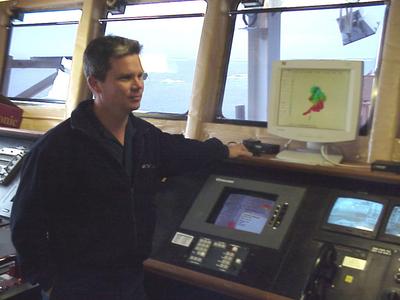
Senior Chief Marine Science Technician Glenn Hendrickson coordinates the operation for the m <> arine science division.

Marine Science Technician Third Class Suzanne Scriven does her MST work and is also responsible for the Platform of Opportunity program for NOAA. It' <> s her job to record and report all marine mammal sightings.
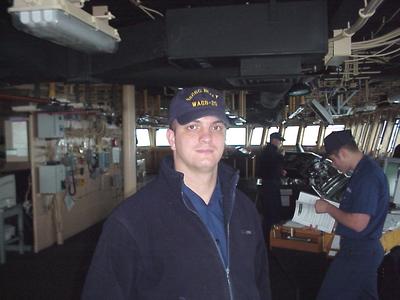
LTJG Mike Woodrum is the Marine Science Officer in charge of the MSTs. Although that is his primary job, he spends a good deal of his time on the bridge driving (conni <> ng) the ship.
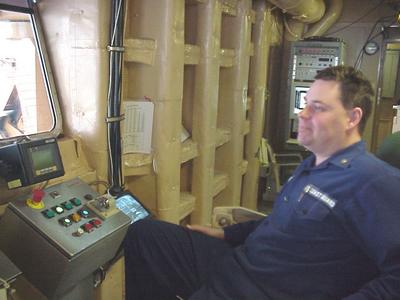
Marine Science Technician First Class Sean Kuhn does all the jobs of an MST and, in addition, has a collateral duty as the Science Network Administrator. <>
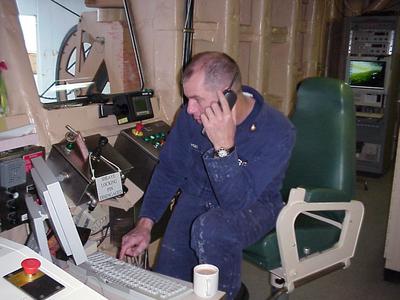
Chief Petty Officer Mike Hamerski is the Assistant Chief of Science, a role that involves personnel management. <>
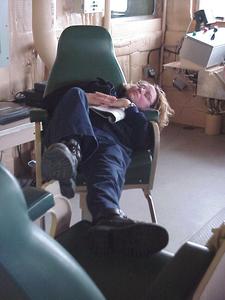
Marine Science Technician Second Class Bridget Cullers is another MST with a collateral duty. She's the Hazardous Materials Coordinator for the ship. She must inventory and keep track of all the hazardous material stored on board. Bridget is seen here taking the opportunity to catch up on a little sleep, something we all do! <>
Contact the TEA in the field at
.
If you cannot connect through your browser, copy the
TEA's e-mail address in the "To:" line of
your favorite e-mail package.
|
